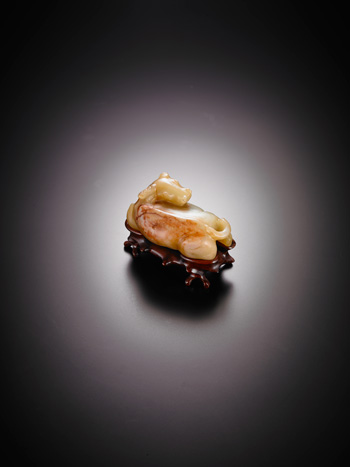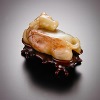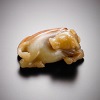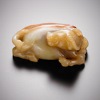The buffalo crouches with legs bent and its gentle expression is intended to evoke the benevolence of the god worshiped as the water deity who controlled irrigation. Moreover, due to its purpose as a farm animal, it is also connotative of the spring and agriculture and more specifically, its endurance and physical strength. These qualities can be seen in the present lot, as the heavy hulk of the buffalo’s body and study legs. The contours of the back and the recesses accentuating the horns depicted on the present lot are distinctive qualities. Compare with a buffalo carving modeled in a very similar posture in the Collection of the Asian art museum of San Francisco, illustrated in Later Chinese Jades – Ming dynasty to early twentieth century, San Francisco, pl.44, p.73. Another jade buffalo dated to the mid-Ming is illustrated in Chinese jades of five centuries, Charles E. Tuttle company, Tokyo, pl.9, pp.56-57.
|
8023
A YELLOW JADE BUFFALO CRAVING
MING DYNASTY |
|
Well carved as an buffalo with its head turned backwards below curved horns of his mount, lying with forelegs tucked underneath and its tail curled, the hooves carved in relief on the underside, the yellow stone of with russet inclusions. |
|
Estimate
550,000 - 880,000 2,148,000 - 3,438,000 70,900 - 113,400
|
|
|
The buffalo crouches with legs bent and its gentle expression is intended to evoke the benevolence of the god worshiped as the water deity who controlled irrigation. Moreover, due to its purpose as a farm animal, it is also connotative of the spring and agriculture and more specifically, its endurance and physical strength. These qualities can be seen in the present lot, as the heavy hulk of the buffalo’s body and study legs. The contours of the back and the recesses accentuating the horns depicted on the present lot are distinctive qualities. Compare with a buffalo carving modeled in a very similar posture in the Collection of the Asian art museum of San Francisco, illustrated in Later Chinese Jades – Ming dynasty to early twentieth century, San Francisco, pl.44, p.73. Another jade buffalo dated to the mid-Ming is illustrated in Chinese jades of five centuries, Charles E. Tuttle company, Tokyo, pl.9, pp.56-57.



